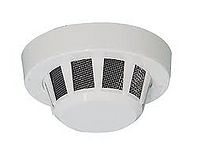Smoke Detection Systems
Smoke Detection Systems configured to trigger alarm system immediately upon detection of smoke.
Work Principles
This reduction in the ionized particles results in a decrease in the chamber current that is sensed by electronic circuitry monitoring the chamber. When the current is reduced by a predetermined amount, a threshold is crossed and an “alarm” condition is established.
Changes in humidity and atmospheric pressure affect the chamber current and create an effect similar to the effect of particles of combustion entering the sensing chamber. To compensate for the possible effects of humidity and pressure changes, the dual ionization chamber was developed and has become commonplace in the smoke detector market.
A dual-chamber detector utilizes two ionization chambers; one is a sensing chamber, which is open to the outside air. The sensing chamber is affected by particulate matter, humidity, and atmospheric pressure. The other is a reference chamber, which is partially closed to outside air and is affected only by humidity and atmospheric pressure, because its tiny openings block the entry of larger particulate matter including particles of combustion. Electronic circuitry monitors both chambers and compares their outputs. If the humidity or the atmospheric pressure changes, the outputs of both chambers are affected equally and cancel each other. When combustion particles enter the sensing chamber, its current decreases while the current of the reference chamber remains unchanged. The resulting current imbalance is detected by the electronic circuitry. There are a number of conditions that can affect dual-chamber ionization sensors such as dust, excessive humidity(condensation), significant air currents, and tiny insects. All of these can be misread as particles of combustion by the electronic circuitry monitoring the sensors.
Common Functions and Applications
Often smoke detectors are utilized to control ancillary equipment. Care should be taken to ensure that detectors utilized in such a manner are approved for their intended purpose. A few of the typical applications are as follows:
- to control the flow of smoke in air handling and air conditioning systems,
- to release doors to contain smoke in a fire situation,
- to release locks to allow exit in a fire situation,
- to capture and recall elevators in a fire situation,
- to activate a suppression system.
Spacing and placement requirements for detectors used in releasing service may be different from detectors used in conventional open area applications. 4-wire detectors are recommended in these situations because the control panel and detectors used will affect the power requirements. More than one detector relay on a circuit may not receive enough power from the 2-wire circuit to operate during an alarm.
Considerations in Selecting Detector Systems
The characteristics of an ionization detector make it more suitable for detection of fast flaming fires that are characterized by combustion particles in the 0.01 to 0.4 micron size range. Photoelectric smoke detectors are better suited to detect slow smoldering fires that are characterized by particulates in the 0.4 to 10.0 micron range. Each type of detector can detect both types of fires, but their respective response times will vary, depending on the type of fire.
It is often difficult to predict what size particulate matter will be produced by a developing fire because the protected buildings normally contain a variety of combustibles. The fact that different ignition sources can have different effects on a given combustible further complicates the selection.
A lit cigarette, for example, will usually produce a slow smoldering fire if it is dropped on a sofa or bed. However, if the cigarette happens to fall upon a newspaper on top of a sofa or bed, the resulting fire may be better characterized by flames rather than by smoldering smoke.
The innumerable combustion profiles possible with various fire loads and possible ignition sources make it difficult to select the type of detector best suited for a particular application.
==Video==
